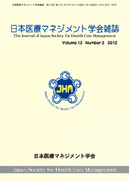Volume 14, Issue 4
Displaying 1-9 of 9 articles from this issue
- |<
- <
- 1
- >
- >|
Original Articles
-
Article type: Original Articles
2014Volume 14Issue 4 Pages 171-178
Published: March 01, 2014
Released on J-STAGE: April 01, 2021
Download PDF (1089K)
Case Reports
-
Article type: Case Reports
2014Volume 14Issue 4 Pages 179-188
Published: March 01, 2014
Released on J-STAGE: April 01, 2021
Download PDF (3448K) -
Influences of the East coast Japan great earthquake disaster to the operation and the operating roomArticle type: Case Reports
2014Volume 14Issue 4 Pages 189-196
Published: March 01, 2014
Released on J-STAGE: April 01, 2021
Download PDF (1465K) -
Article type: Case Reports
2014Volume 14Issue 4 Pages 197-202
Published: March 01, 2014
Released on J-STAGE: April 01, 2021
Download PDF (1503K) -
Article type: Case Reports
2014Volume 14Issue 4 Pages 203-208
Published: March 01, 2014
Released on J-STAGE: April 01, 2021
Download PDF (742K) -
Article type: Case Reports
2014Volume 14Issue 4 Pages 209-212
Published: March 01, 2014
Released on J-STAGE: April 01, 2021
Download PDF (904K) -
Article type: Case Reports
2014Volume 14Issue 4 Pages 213-217
Published: March 01, 2014
Released on J-STAGE: April 01, 2021
Download PDF (882K) -
Article type: Case Reports
2014Volume 14Issue 4 Pages 218-222
Published: March 01, 2014
Released on J-STAGE: April 01, 2021
Download PDF (575K)
Introductory Reports
-
Article type: Introductory Reports
2014Volume 14Issue 4 Pages 223-226
Published: March 01, 2014
Released on J-STAGE: April 01, 2021
Download PDF (1026K)
- |<
- <
- 1
- >
- >|
